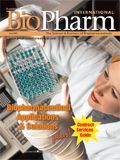Economy and Reproducibility: Varying Virus Spike Conditions on a Planova 20N Virus-Removal Filter
Introduction; Materials and Methods
Introduction
The virus removal or inactivation capacity of a biopharmaceutical manufacturing process should be proven in a virus validation study. Virus spike concentration and purity can potentially affect the LRV obtained. Additionally, such a study can affect the economy of processing. In particular, if the effect of a more concentrated biotherapeutic on virus-validation profile is minimal, the economy of the filtration can increase. A more robust method can affect economy by maintaining reproducibility despite process variation. The effects of varying IgG concentration, PPV purity and PPV percentage of spike on the performance of Planova 20N virus-removal filters were studied. Design of virus clearance studies, as well as safe and economic virus-filter usage, is considered.
Materials and Methods
Serum or serum-free PPV supernatants were collected, centrifuged at low speed, and 0.45 μm filtered to obtain stock solutions. For purified PPV, following 0.45 μm filtration, ultracentrifugation and density gradient centrifugation were applied. Serum, serum-free, and purified PPV solutions were then used for spiking. The spike percentages were 0.5 or 3.0 vol% for serum-free PPV, 1.0 vol% for serum PPV, and 0.01 vol% for purified PPV. The concentrations of human IgG were 1–30 mg/mL. The non-spiking or spiked IgG solution were prefiltered by Planova 35N to remove aggregates. Filtration was performed in dead-end mode at 0.8 kgf/cm2 (11.4psi).

Figure 1
Results
The Planova 20N flux was not affected by the PPV purity and was identical in the presence and absence of PPV (data not shown). Also, the PPV LRV remained >4 over the filtration volume of 200L/m2 under various spiking conditions. In the non-serum PPV spiking (3vol%) case, a high PPV LRV was maintained past 500L /m2 . (Figure 1) Additionally, for all samples tested, the filtration capacity was not affected by virus purity. (Figure 2)
Discussion
An inaccurate or poorly designed scale-down model can introduce factors that produce incorrect or uninterpretable results in virus-clearance studies. A higher virus spike percentage can overcome virus-assay limitations; however, this can decrease the filtration performance if not chosen wisely. We routinely recommend PPV spike percentages at contract laboratories up to 1% without problem, and XMuLv spike percentages up to 0.5%. Our data shows that purified virus is not a factor under the conditions studied.
Production economy is dictated by the capacities of the materials used to process biotherapeutic material. In particular, a material that consistently performs over a wide variation in challenge can be said to be robust. In the specific case of a virus-removal filter, a virus validation can dictate the V/m2 ratio, based on the margin at which a minimal LRV=4 is maintained. Ideally, a robust virus-removal filter will maintain LRV=4 through a wide concentration range. In the case of MAb's, this range could be 1–5mg/mL to upwards of 20mg/mL, or higher.

Figure 2
Assuming normalized cost and similar V/m2 ratios, a bioprocess solution with two or three times higher concentration can result in a virus-filtration cost that is significantly lower on a robust filter. Simply put, the throughput on a g/m2 basis, with such a robust filter, could be much higher. This would serve to decrease filter per-unit cost, suite processing time, and filter integrity testing required. Additionally, if there is variation in the process at all (concentration, aggregation, etc.), robustness will also maintain reproducibility, which can serve to decrease costs associated with process exceptions and delays.
Conclusions
Planova 20N virus-removal filters demonstrate predictable and well-balanced performances that are unaffected by varying IgG concentration, virus purity, or spike percentage (i.e., constant protein filterability and consistent high LRV). This can serve to increase the economy and reproducibility of virus removal.
References
1. T.Hongo-Hirasaki, K.Yamaguchi, K.Yanagida, K.Okuyama, Removal of small viruses (parvovirus) from IgG solution by virus removal filter Planova20N. Journal of Membrane Science. Jul 2006;78(5):3–9.
2. K.Yamaguchi, E.Miyagawa, M.Dan, T.Miyazaki, H.Ikeda. Cellulose hollow fibers (BMMs) used in the filter membrane can trap human parvovirus (±9). 15th ICEM Durban. South Africa. 2002;115–116.
3. T.Hongo-Hirasaki, K.Yamaguchi, K.Yanagida, K.Okuyama. Effects of varying virus-spike conditions in a virus-validation study on a Planova virus removal filter. IBC's 9th International Conference on well characterized biologicals and viral safety. VA, USA. 2005;Nov. 14–15.
Company info
Asahi Kasei Medical America
Long Island Branch, Planova Division
1600 Stewart Avenue, Suite 602
Westbury, NY 11590
Tel: 877.PLANOVA
Fax: 516.620.3135
Email: mmorgan@ak-america.com
Website: www.ak-america.com

VERAXA and Voyager to Create Combined Business for Advancing Pipeline of Next-Gen Cancer Therapies
April 23rd 2025The proposed business combination would create a publicly traded, clinical-stage biopharmaceutical company that will focus on developing a pipeline of next-generation cancer therapies.
Mastering Antibody-Drug Conjugates
December 19th 2024In this episode, we explore BIOVECTRA’s capabilities in antibody-drug conjugate (ADC) manufacturing, from complex conjugation chemistry to synthesis of highly potent payloads. We’ll also showcase how BIOVECTRA’s extensive experience in complex chemistries and specialized small molecule manufacturing gives them a unique perspective, strengthening their approach to ADC production and ensuring clients receive custom solutions across all project stages.
MHRA Approves GSK Therapy Combinations for Multiple Myeloma
April 21st 2025Belantamab mafodotin is approved in combination with bortezomib plus dexamethasone in patients who have had at least one prior therapy, and in combination with pomalidomide plus dexamethasone for those who have had a prior therapy including lenalidomide.
Tokyo University of Science Research Team Explores Improved Delivery of Antisense Oligonucleotides
April 18th 2025Using cholesterol-modified oligonucleotides, the research team aims to improve the delivery of antisense nucleotide-based therapies for treating neurodegenerative diseases and brain cancers.